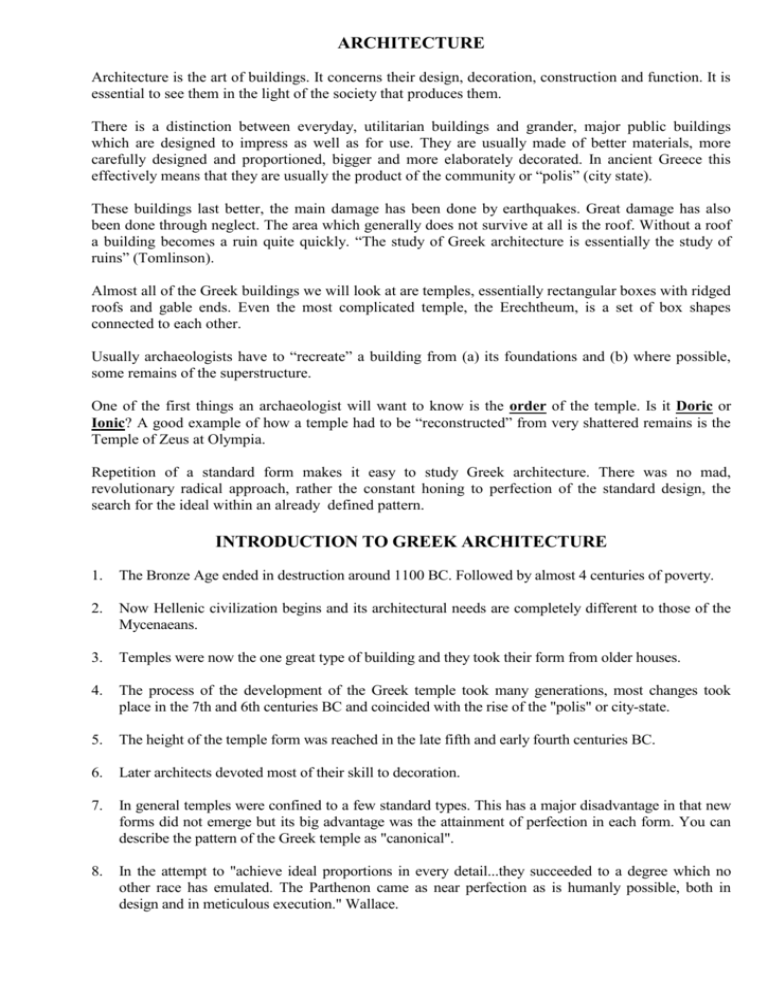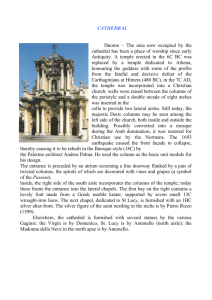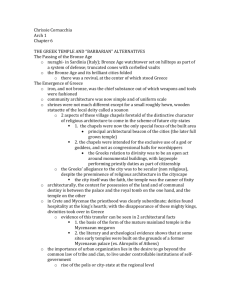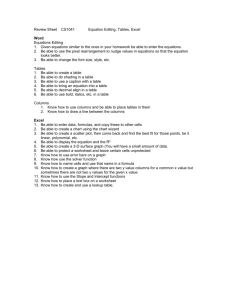ARCHITECTURE Architecture is the art of buildings. It concerns their
advertisement

ARCHITECTURE Architecture is the art of buildings. It concerns their design, decoration, construction and function. It is essential to see them in the light of the society that produces them. There is a distinction between everyday, utilitarian buildings and grander, major public buildings which are designed to impress as well as for use. They are usually made of better materials, more carefully designed and proportioned, bigger and more elaborately decorated. In ancient Greece this effectively means that they are usually the product of the community or “polis” (city state). These buildings last better, the main damage has been done by earthquakes. Great damage has also been done through neglect. The area which generally does not survive at all is the roof. Without a roof a building becomes a ruin quite quickly. “The study of Greek architecture is essentially the study of ruins” (Tomlinson). Almost all of the Greek buildings we will look at are temples, essentially rectangular boxes with ridged roofs and gable ends. Even the most complicated temple, the Erechtheum, is a set of box shapes connected to each other. Usually archaeologists have to “recreate” a building from (a) its foundations and (b) where possible, some remains of the superstructure. One of the first things an archaeologist will want to know is the order of the temple. Is it Doric or Ionic? A good example of how a temple had to be “reconstructed” from very shattered remains is the Temple of Zeus at Olympia. Repetition of a standard form makes it easy to study Greek architecture. There was no mad, revolutionary radical approach, rather the constant honing to perfection of the standard design, the search for the ideal within an already defined pattern. INTRODUCTION TO GREEK ARCHITECTURE 1. The Bronze Age ended in destruction around 1100 BC. Followed by almost 4 centuries of poverty. 2. Now Hellenic civilization begins and its architectural needs are completely different to those of the Mycenaeans. 3. Temples were now the one great type of building and they took their form from older houses. 4. The process of the development of the Greek temple took many generations, most changes took place in the 7th and 6th centuries BC and coincided with the rise of the "polis" or city-state. 5. The height of the temple form was reached in the late fifth and early fourth centuries BC. 6. Later architects devoted most of their skill to decoration. 7. In general temples were confined to a few standard types. This has a major disadvantage in that new forms did not emerge but its big advantage was the attainment of perfection in each form. You can describe the pattern of the Greek temple as "canonical". 8. In the attempt to "achieve ideal proportions in every detail...they succeeded to a degree which no other race has emulated. The Parthenon came as near perfection as is humanly possible, both in design and in meticulous execution." Wallace. 9. Of the types, the Doric Order is generally seen as the most perfect, the others were related to it and the same few structural methods were used. Up to the very end the clear signs were there of the adaptation in stone of timber and unbaked brick buildings. 11. The purpose of the Greek temple was to house a deity, not to accommodate worshippers. It originated in the form of a Dark Age house, i.e. a room with a porch usually with two columns to support the roof. 12. It is debatable whether the Mycenaean megaron had an influence. 13. The primitive temple must have been thatched and ridge-roofed. An important early example of a grave monument at Lefkandi in Euboea (an island near Athens) dates from the 10th century BC and is surrounded by a veranda supported by wooden columns. This was probably to keep the walls dry. But it was very expensive to do this in stone or marble so very early stone temples usually had just two columns in the porch. 14. The first cut stone buildings date from the 7th century BC. Maybe influenced by Egypt, also brought on by the invention of roofing tiles (very heavy). So the design was determined by the early houses and by the demands of the roof tiles (it was easier to tile a rectangular roof). 15. The early examples seem to have had stone walls and wooden columns, later ones were made of stone. "Every detail of the whole system from the foot of the columns to the gutter is an apparent translation from carpentry...The position and shape of every portion never varied". Wallace. 16. The two orders took their name from the two main dialects of Greek spoken in their respective areas. Broadly Doric began and remained the style of the Greek mainland and of the Western colonies, Ionic was that of some of the Aegean islands and the coast of Asia Minor. 17. It was soon realised that there was one big problem in translating from wood and brick to stone, and that was weight. Stone is heavier and has less tensile strength so thicker proportions were needed. 18. When more confidence was gained, the tendency was reversed, especially in Doric as the columns became more slender. The early ones are very chunky. 19. Once marble came into use, it was harder and more reliable than stone the best proportions were developed. Another feature of marble was its capacity for sharp definition and polished surface. 20. One fact is often used to account for the static nature of Greek architecture and that is their failure to exploit vaults and arches. This was left to the Romans to achieve. "But the excessive conservatism of Greek architecture has been justified by its perfection and because of the infinite variety of treatment possible within each type" Wallace. BUILDING MATERIALS AND METHODS 1. We know that early temples were built of mud-brick and stone, probably with thatched, or later tiled roofs. 2. Later, the Greeks began, probably under the influence of trade with the Egyptians who were experienced builders in stone, to build their temples out of local stone, usually limestone or conglomerate. Occasionally there is evidence of temples made of a combination of wood and stone (eg. Temple of Hera at Olympia). 3. It must have become obvious quickly that building a temple entirely out of stone made it more solid and was also a better way of securing the roof support. 4. As the 6th century continued, they began to use a particular type of stone - marble - more and more. It had pros and cons: it is a very dense stone and particularly heavy, prone to cracking in places. It was, therefore, very expensive to transport. But aesthetically, its advantages were obvious. Its creamy white colour and its consistency which meant it could be cut very finely and polished smoothly were far superior to other types of stone, which usually needed to be stuccoed and painted. The most famous quarries were at Paros, Naxos and Mount Pentelikon (16km from Athens). The coast of Asia Minor also had plentiful marble quarries. The Parthenon is built of marble from Mount Pentelikon, but its roof tiles are Parian marble. 5. Blocks of marble were cut at the quarry using wooden wedges to roughly the size and shape required by the architect. "Ancones" or lifting bosses were left on the sides for easy lifting. Sometimes holes were drilled in the blocks so that ropes could be passed through for lifting. Even the largest temples tended to be built using blocks small enough to lift fairly easily. 6. Blocks were transported from the quarry by sleds on tracks, then ox-carts and mule carts. They also probably used rolling wooden frames to haul the marble. 7. Primitive cranes based on pulleys and winches were in use. 8. No putty or cement of any kind was used to hold the blocks together. Instead they used metal cramps of various shapes to help to hold the blocks in place (commonly used were the dovetail, double T, butterfly or H shapes). 9. Another technique used to prevent the blocks from slipping was called anathyrosis where the outer edges of the blocks were polished smooth, but the inner surfaces were left rough for better grip. 10. Early columns were monolithic (eg Temple of Apollo at Corinth) but in the 6th century Theodorus of Samos seems to have invented a lathe on which stone could be turned and increasingly columns were assembled from several drums. The drums were centred using wooden dowels. 11. We know from the Temple of Apollo at Segesta in Sicily that the first element to be built on the stylobate was the peristyle (columns all around the outside). This temple was left unfinished and we can tell from it also that the column fluting was done only when the building was complete. Though it is probable that the fluting of the very top and bottom was done before the columns were assembled. 12. Tools used for the sculpting of architectural details were mallets and chisels (flat-blade, toothed and claw) Finishing was done by sanding and polishing. 13. We gather from a variety of sources (inscriptions and written accounts from the time) that the main sources of funding for these buildings were: wealthy individuals (eg. Alkmaeonids who built the Temple of Apollo at Delphi); fines from enemies or criminals; city taxes or loans guaranteed by wealthy citizens. Remarkably, from an inscription concerning the Erechtheum on the Athenian Acropolis, we see that all of the workers (including the architects) received 1 drachma a day for their labour. 14. The cost of these buildings is hard to calculate exactly but we know that the Parthenon took 22 tonnes of marble to build and cost a year's income for the city of Athens. Still not as much as the gold and ivory statue of Athene it was built to house! 15. When the roof tiles were in place (pan tiles joined by ridge tiles), the ends of the cover tiles were decorated with antefixes in the shape of heads or leaves. 16. Finally, 6 acroteria were placed at each corner of the roof and on the point of each pediment. On the Parthenon these were in the shape of huge symmetrical floral designs. 17. The effect of the antefixes and acroteria was probably to soften the line of the roof. 18. As well as all of this, the building was also decorated with sculpture and painted designs. THE DEVELOPMENT OF THE DORIC ORDER 700-400 BC. 1. Much of the Doric Order and its decoration grew from its original form in timber. The Temple of Poseidon at Corinth had stone walls but wooden columns. 2. Very early temples were extremely long and narrow (eg. the Temple of Hera at Samos). 3. Early columns tend to be monolithic (Temple of Apollo at Corinth), close together, ( the Basilica\Temple of Hera at Paestum) and noticeably tapered, (the Temple of Artemis at Korkyra in Corfu). Later columns are made up of drums, are spaced more widely (as confidence was gained) and the tapering becomes more gentle. Also entasis is added for effect. 4. Early capitals tend to be very wide and bulbous (Temple "C" at Selinus) whereas the later ones become more gradual in their curve and more elegant (Parthenon). 5. Early temples were made of local stone, stuccoed with plaster, (Temple "C" at Selinus), a transitional temple (of Apollo at Delphi) had a marble facade and later the Parthenon was built entirely of marble. 6. Decoration became richer in later temples and there was more and more emphasis on proportion and harmony. Refinements culminated in the Parthenon in Athens. THE DORIC ORDER 1. The earliest eg. of a stone temple is the Temple of Hera at Samos dating back to around 800BC. 2. It is the oldest known peripteral temple. It was very long and narrow. Its entrance (in common with many later temples) was facing east. It had no porch and had one row of columns down the centre of the naos. Its columns must have been of wood. 3. Most of the other very early temples found did not have peristyles. 4. By the mid-7th century most Greek mainland temples were roofed with tiles. This caused huge consequences above all stimulating the improvement of walls and a changeover from wooden to stone columns. The early tiles were very heavy (up to 30 kilos). 5. A leading part in these new structures was played by Corinth in the 7th century BC. Two crucial early temples were found here, the Temple of Apollo (see p.28) and the Temple of Poseidon. 6. The Temple of Poseidon had stone walls and a wooden peristyle. 7. By the early 6th century Greek mainland architects were beginning to construct entirely of stone up to the wooden roof beams and terracotta tiles. "In colonnades and above all in entablature the forms of developed 7th century wooden architecture were retained to the end". Lawrence. 8. So by the start of the 6th century the essential Doric order was formed. 9. The foundations were made of roughly dressed masonry, laid only below the essential areas of the building. On top was a level base for a platform which usually had three steps often very high. From the late 6th century the stylobate (top step) is not flat but slopes down to either side. This was originally for drainage but was seen to have aesthetic value. It led to the sloping inwards of columns again, aesthetically appealing. 10. In Doric columns the shaft almost invariably stands directly on the floor. Early columns are usually monolithic. Later ones are made up of drums probably turned on a lathe. Evidence from some quarries indicates that the drums were cut ready-rounded. 11. The drums were dowelled together by spikes of bronze or wood enclosed in wooden blocks so that the material could expand or contract. In temples the columns were always fluted. This was done after the column was put up. 12. The flutes are almost always concave, broad and shallow and meet to form sharp edges. The normal number of flutes was 20. 13. Why was it there? Possibly as an echo of the grain of wood, possibly the early wooden shafts had been carved with a rounded blade, it certainly emphasised the shaft as opposed to the masonry joins and it lifted the appearance of the column. 14. The capital consists of two parts and probably derives from a wooden original. The echinus (literally sea-urchin) is like a cushion and spreads outwards from the top of the shaft. The overlying slab is the abacus. 15. The original idea was probably to spread the weight between two slabs of wood and prevent the post from splitting. The stone capital is usually carved out of a single block which also extended a few inches down the shaft. 16. The shapes of the parts of the column stayed the same (although proportions changed) except for the echinus which became a more gradual and softer curve. 17. The early columns tend to be much thicker than the later ones and to taper more dramatically. Columns of the late 5th century are perfect to the eye but they are still in fact bulkier than is necessary. By the 4th century they are narrower again. Early architects underestimated the strength of stone columns and placed them much too close together. 18. Above the capitals of the columns was the architrave, a plain band of stone. The junctions between the beams of the architrave always stood directly above the centre of the columns. In the Doric order it was very rarely decorated. 19. Next was a thin shelf with a series of plain bands (regulae) over each triglyph. Under each of these is a row of cylindrical pegs (guttae). 20. The Doric Frieze was just above the taenia and consisted of alternating triglyphs and metopes. Each triglyph consists of one block carved to look like three upright bars each with three facets.The metopes are thin slabs between the triglyphs either plain or decorated with painting or sculpture. In theory each triglyph over a column should be centered precisely but there was a problem with the corners where two triglyphs met at right angles. 21. Gradually the whole entablature became lower which led to the lightening of the structure. In the 6th century it is half as high as the columns, by the 4th century it is one quarter as high. 22. Above the frieze is the cornice surrounding the entire temple. A second cornice slants up the gable. The underside of the horizontal cornice has carved peg shapes (derived from wood) called mutules. 23. The roof was supported on wooden cross-beams which formed a square pattern when you looked up and were covered with coffers. Wood was the normal material for ceilings despite the risk of fire. Above the ceiling were the rafters supporting the roof tiles of two main types, Lakonian and Corinthian. In the 5th and 4th centuries, marble was used. The roof was finished off with a gutter or sometimes antefixes to hide the tile ends. At each corner were acroteria. DECORATION OF THE DORIC ORDER Some of the early temples of wood and mud-brick seem to have been decorated (and protected) by terracotta facings. Even into the latest temples terracotta antefixes survived as they were easy to produce from moulds, lasted and were light. Statues of terracotta were used in early pediments, indeed the pediment may have been created to receive such sculptures. These sculptures were not merely decorative, they serve to blur the sharp geometric lines of the building, to counteract the upward sweep and perhaps were intended to frighten away evil. They also usually told a story connected with the particular cult. Colour was also applied to Greek buildings. The white Pentelic marble was dazzling newly cut and in sunlight. It is possible that varnish was used to cut down on the glare giving a yellowish tone (evidence from Macedonian tombs supplies this). But in general colour was used to emphasize and pick out detail. Traces of colour survive on some buildings. Obviously the tones have faded. The important colours are blue, imported from Egypt, red (native ochre), and yellow gold. Green is used very little. In the Doric order colour is used on the entablature mainly. The frieze is framed between two red bands (the taenia and the band under the cornice). Sometimes these bands were decorated with a gold meander pattern. The triglyphs are blue and the band over the metopes is blue also. The regulae are blue as are the mutules. Mouldings are usually coloured in blue, red and gold. On the Parthenon the painted decoration seems to have been especially elaborate on the cornice. The metopes of the Parthenon seem to have been backed in red. Also the coffered ceiling of the Parthenon had elaborate decorations. The method of colour application is not sure, some argue that it was hot wax, but often the pattern remains even when the colour is gone. An important source of information on colour is a 19th century archaeologist called Penrose who recorded the colours when they were less faded. The main function of colour was the clear demarcation of parts Another feature of the Doric Order was the entasis used on the columns. This was a slight bulge in the tapering column, about two thirds the way up which softened its lines. It is important to note that the Greek Temple was designed to be viewed externally and from all angles. The history of Doric is the perpetual search for perfect proportions without the use of detailed drawings as the Greeks do not seem to have had scale rulers. It is generally accepted that this perfection was reached in the Parthenon. THE IONIC ORDER 1. See diagram of Ionic order and differences between it and the Doric order. 2. What are they? Horizontally fluted bases; more slender columns; more fluting; flat fillet between flutes; volute (or ram’s horns) capitals; often plant decoration under the capitals; very eastern in its usage; sometimes a narrow abacus above the capital, but not always; entablature often broken into three steps; frieze – very important, continuous and usually decorated (either with dentals or with sculpted figures). 3. Pedley describes the Ionic order as “much more restless visually”. More variety and ornament. He calls the Doric order “more integrated and sturdier”. 4. Earliest Ionic temples were in Asia Minor at Ephesus and Didyma and Samos. Sometime in the mid-6th century B.C. a massive Ionic temple was built on the island of Samos by Rhoikos and Theodorus, with a double colonnade all around it. It collapsed soon after it was built and a very ambitious replacement was begun surrounded by a triple colonnade. 5. Not to be outdone, Ephesus started a huge temple to Artemis which was about 115m long with massive columns with elaborately carved bases and lower drums. King Croesus helped to pay for it. 6. Another gigantic Ionic temple was at Didyma near Ephesus. This temple was unusual in that it had an open air interior sheltering a small shrine. It has splendid decoration. It was rebuilt in the 4th century B.C. 7. Two of the most famous Ionic temples are the Erechtheum and the Temple of Athene Nike on the Acropolis in Athens. 8. Other examples you might mention are the Temple of Athene Polias at Priene and the use of the Ionic Order on the Pergamon Altar. ARCHAIC TEMPLES 630-480 B.C. 1. No 6th century temple still stands to its full height. Dating is not precise. 2. The oldest peripteral temple in Greece is the Temple of Artemis at Korkyra in Corfu (see Richter p.27). It was made of limestone and was about twice as long as it was wide. There seem to have been two rows of columns inside the cella. Its Western pediment has been pieced together carved in high relief with a scene of Medusa the Gorgon with her two sons and two leopards. Much smaller figures at the sides show the Battle of the gods and the giants. It dates to around 580 BC. (See Richter p.63). 8 columns at front, triglyphs and plain metopes, Doric. 3. The Temple of Hera at Olympia was built around 600 BC. (See Richter p.27). The walls were built of limestone at the bottom and continued in mud-brick. It was probably finished in wood with a tiled terracotta roof. The wooden columns were later replaced in stone, with great variations in the replaced columns. The cella was divided by two rows of columns, an unusual feature were the spur walls which alternated with the columns. The ceiling was flat. It measures about 160X60 ft. There were acroteria on the pediment. cella, pronaos, opisthodomos, peristyle, 6 columns back and front, 16 columns at sides. 4. Seven columns still stand of the Temple of Apollo at Corinth. It dates to the mid 6th century BC. Each shaft is a monolith about 21 feet high with 20 flutes. The rough limestone was faced with stucco made of marble dust. It is the earliest instance of the floor rising in a convex curve. The building had two cellas back to back. Its length was two and a half times its width. (See Richter p.28). cella, pronaos, opisthodomos, peristyle, 6 columns back and front, 15 columns at sides, two rows of columns inside the cella 5. The temples of Sicily and southern Italy are hugely important. One example in Sicily is Temple "C" at Selinus dated to the mid 6th century BC. (See Richter p.28). 12 columns of its peristyle still stand. It had a very narrow cella. Its entablature was exceptionally tall (it was more than half as high as the columns). A Gorgon's head of terracotta 9ft high was at the centre of the pediments. The cornice was decorated with ornaments of different designs. cella, pronaos, peristyle, 6 columns back and front, 17 columns at sides, two rows of columns in front of pronaos, opisthodomos opens to cella rather than back, forming a back chamber of the cella 6. In Southern Italy there were many deviations from the standard pattern. Some of their temples do not seem to have been so successful architecturally. A sanctuary to Hera at the mouth of the river Silaris (Sele) has a mid-6th century temple (See Richter p.28). It is badly preserved but seems to have been lavishly decorated. The metopes and triglyphs were carved in one piece. It had Doric capitals with a widely spreading echinus and 2 anta capitals. cella, pronaos, peristyle, 8 columns back and front, 17 columns at sides, opisthodomos opens to cella rather than back, forming a back chamber of the cella, stairs leading from cella to second storey. 7. A gigantic Ionic temple was at the Temple of Artemis at Ephesus (See Richter p.29). Made of marble except for wooden roof and terracotta tiles. It has splendid decoration, with even the bottom drums of some of the columns sculptured. Begun around 550 B.C., it was rebuilt in the 4th century B.C. King Croesus of Lydia gave some of the columns. cella, pronaos, double peristyle (i.e. peripteral temple), 8 columns back and front, 21 columns at sides, opisthodomos opens to cella rather than back, forming a back chamber of the cella 8. The best remains in S. Italy are at Paestum (Poseidonia). Here two 6th century temples and one from the 5th remain in good condition. (See Richter p.30). The oldest is called the "Basilica" now identified as a Temple of Hera. The entire Pteron is standing with the architrave but no wall. It measures 80 x180 feet. The column capitals are unusually decorative. The capitals rise from ornamental neckings. The cella contains a central row of columns, opisthodomos opens to cella rather than back, forming a back chamber of the cella, it has 9 columns on the ends and 18 on the sides, peristyle. 9. Another building with ornamented capitals is the Temple of Athena at Paestum (See Richter p.30). Its entablature was unique, it has an Ionic moulding over the architrave (egg and dart pattern) and in the frieze the triglyphs are set into the wall. There was no horizontal cornice and therefore no pediment. Its sloping cornice was very wide and carved into coffers, each with a star pattern. The capitals rise from ornamental neckings. It has a pronaos with a row of Ionic columns. Quite small, pronaos, cella, no opisthodomos, 6 columns at ends and 13 at sides, peristyle. 10. The most notable Italian temple is that of "Poseidon" (really of Hera) at Paestum (See Richter pp.30-31). It is the best preserved of all temples. It dates from around 460BC (and so qualifies as a classical temple). This is very much influenced by mainland Greece. The columns have 24 flutes rather than the conventional 20. The external columns are 29 feet high and taper by about 2 feet. The columns are very thick for the period. It has two recesses between the porch and the cella, one fitted with a staircase. It has 6 columns on the ends and 14 on the sides, pronaos, naos, opisthodomos, peristyle. 11. The Temple of Apollo at Delphi built by subscriptions from the whole Greek world and the exiled Alkmaionidai family (See Richter p.31). Parian marble used for the front. Sculptures of marble on east and limestone on west pediments. Destroyed by earthquake and rebuilt later. Enclosed room for priestess to pronounce oracles. It has 6 columns on the ends and 15 on the sides, pronaos, naos, opisthodomos, peristyle, two rows of columns in cella and enclosed room, a ramp led up to the entrance. 12. A fine example of an early 5th century is that of the Temple of Aphaia at Aegina (See Richter p.32). She was a local goddess. It is on a magnificent position on a ridge looking over the sea. Enough fragments survive to reconstruct its appearance. It was made of stuccoed limestone. Fragments of marble pediment sculptures survive. The columns almost all were monolithic. The columns slope sharply inwards giving an impression of great strength. They are over 17ft high. The colours used in its decoration seem to be red and black or dark blue on a cream ground. The interior had a two-storeyed colonnade. It has 6 columns on the ends and 12 on the sides, pronaos, naos, opisthodomos with opening into cella, peristyle, two rows of columns in cella, a ramp led up to the entrance. EARLY CLASSICAL TEMPLES (480-450BC) 13. The most remarkable Sicilian building is the Temple of Zeus at Akragas (now Agrigento) (See Richter p.32). This was the largest of all Doric temples (110 x 53m.) It was left unfinished because of the sack of the city around 406BC. (See Richter p.32). The temple was raised 5 steps above a 15ft platform. Its design is very unusual. It had a pseudo-peristyle of engaged columns along a continuous wall with a series of mouldings along the bottom. The entire structure was built with comparatively small blocks which would have saved money on transport. The joins would have been covered with stucco. The distance of axis to axis of each column was the greatest of any Doric temple, 27ft. In between each column was a massive figure of a man over 25ft high with lowered head and raised arms as if carrying the entablature. It has 7 columns on the ends and 14 on the sides, small pronaos, naos, no opisthodomos, peristyle along a continuous wall, two rows of piers (square pillars) in cella set along a continuous wall 14. The Temple of Zeus at Olympia (See Richter p.32). was designed by a local architect, Libon of Elis, and measured 30 x 65m. It was begun around 470BC. Nothing above the lowest column drums stands but Pausanias, a Greek traveller of the 2nd century AD described it in detail and it has been lovingly excavated. It was stuccoed limestone apart from marble decoration and sculptures. Libon seems to have been deeply interested in proportions which he designed using simple ratios. It was best known in the ancient world for its cult statue of Zeus by Pheidias, one of the seven wonders of the ancient world. It was a seated statue of Zeus, 40ft high. The pediment statues are exceptionally well preserved (See Richter pp.96,101&108-109). There were two stairs leading up to two galleries to view the statue and the entrance to the porch had three double doors of bronze. It has 6 columns on the ends and 13 on the sides, pronaos, naos, opisthodomos, peristyle, two rows of columns in the cella, a ramp led up to the entrance.






